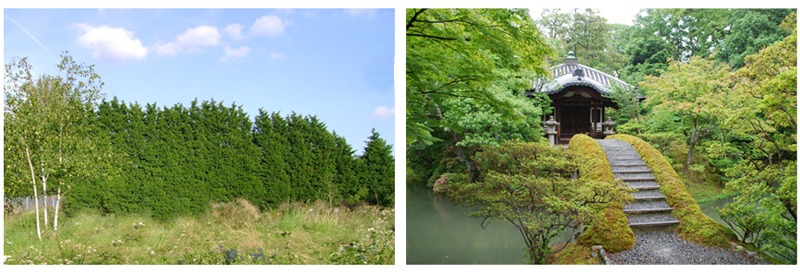 Short-term thinking produces such horrors as the ‘useful quick-growing screen’, achieved (left) with Lawson’s Hated Cypress (Chamaecyparis lawsoniana ‘Horribilis’). Long-term thinking produces such masterpieces as Katsura Imperial Villa (right).
Short-term thinking produces such horrors as the ‘useful quick-growing screen’, achieved (left) with Lawson’s Hated Cypress (Chamaecyparis lawsoniana ‘Horribilis’). Long-term thinking produces such masterpieces as Katsura Imperial Villa (right).
It is a sobering thought, for the highly trained professional designer, that most of the world’s best gardens owe their brilliance to the work of owner-designers – not to professional designers. One thinks of Katsura Palace, the Taj Mahal, Sissinghurst and Little Sparta. Then one thinks of all the billions spent on public parks in the twentieth century: they produced a few good designs, a mass of trash and nothing in the first order of excellence. Think of the Parque Juan Carlos I . It must make the poor old King of Spain think about abdication (or just about changing its name to Parque General Franco?).
There is one outstanding candidate amongst many possible explanations for the problem. Professional designers think about making an impact on their immediate clients and their peers; owner-designers have often belonged to dynasties with a concern for the very long term future of their property in general and their gardens in particular. They combine the essentials of ‘ownership and control’ with a sense of duty to the past and duty to the future. Garden designers and landscape architects can assist only with help from enlightened patrons.
To make better public gardens and landscapes we require very much better patronage. What can the modern world do? Reinstate primogeniture? Abolish inheritance tax? Bring back the aristocracy?
HAPPY NEW YEAR TO ALL OUR READERS

Perhaps a better appreciation of the importance of temporality as well as garden typology would assist. Modernity has seen a lessening of emphasis on the long term, but it has increased and enriched the available typological order.
Unfortuneately, for designers the short term is often seen as;
1. all there is – so fashion and the moment is everything
2. of no value at all – so only large public commissions count
Whereas each garden typology has its particular temporality – ie. Short term: Chelsa for experimentation and trends in garden design and Long term: Large parks and palatial gardens for excellence.
Of course, this is a simplistic division. Something may be created at Chelsa which is so extraordinary that either the public or the profession demand that it be kept. While a large public commission may be so badly executed that it is unworthy of being kept even for the expected duration of the garden design.
And there is much that is relevant to the medium term….urban commissions require longer spans for planning and execution….but they are by nature often temporary because of the constant pressure for cities to evolve to meet changing needs and expectations. It is in the medium term that the greatest challenges arise and there is the greatest requirement to be well versed in the importance of temporal judgments. It is here that the designer is responsible for the best of the past, for meeting the need of the present and for looking towards and anticipating the future!
It may be that landscape designers are especially versed in adopting the medium term view because of the fundamental nature of garden design. It requires patience to realise a design. Plants must mature and the garden be maintained for the design to take its intended shape.